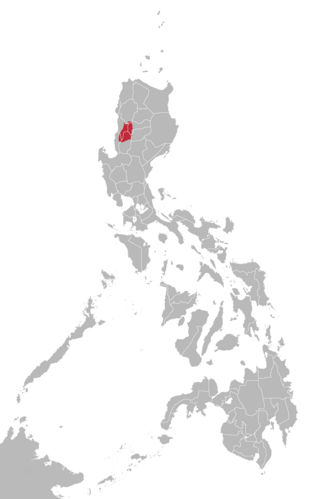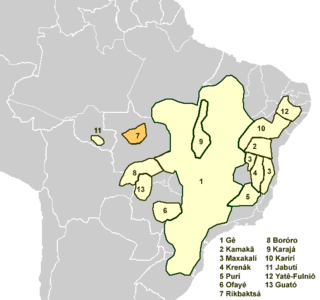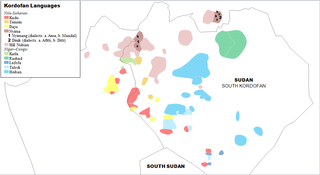Related Research Articles
The Saho language is an Afro-Asiatic language spoken in Eritrea, Sudan and Ethiopia. It belongs to the family's Cushitic branch.
Berta proper, a.k.a. Gebeto, is spoken by the Berta in Sudan and Ethiopia. As of 2006 Berta had approximately 180,000 speakers in Sudan.

Kankanaey is a South-Central Cordilleran language under the Austronesian family spoken on the island of Luzon in the Philippines primarily by the Kankanaey people. Alternate names for the language include Central Kankanaey, Kankanai, and Kankanay. It is widely used by Cordillerans, alongside Ilocano, specifically people from Mountain Province and people from the northern part of the Benguet Province. Kankanaey has a slight mutual intelligibility with the Ilocano language.
Turkana is the language of the Turkana people of Kenya and Ethiopia. It is spoken in northwestern Kenya, primarily in Turkana County, which lies west of Lake Turkana. It is one of the Eastern Nilotic languages, and is closely related to Karamojong, Jie and Teso of Uganda, to Toposa spoken in the extreme southeast of South Sudan, and to Nyangatom in the South Sudan/Ethiopia Omo valley borderland; these languages together form the cluster of Ateker Languages.
Kuman is a language of Chimbu Province, Papua New Guinea. In 1994, it was estimated that 80,000 people spoke Kuman, 10,000 of them monolinguals; in the 2000 census, 115,000 were reported, with few monolinguals. Ethnologue also reported 70,000 second language speakers in 2021.
Naba is a Nilo-Saharan language spoken by approximately 500,000 people in Chad. Those who speak this language are called Lisi, a collective name for three closely associated ethnic groups, the Bilala, the Kuka and the Medogo, that represent the three dialects in which Naba is subdivided. They live mainly in the Batha Prefecture, but the Kuka are also in Chari-Baguirmi. Ethnologue estimates the lexical similarity among the three dialects to be no less than 99%. Arabic is often spoken as a second language.
Chiripá Guarani, also known as Ava Guarani and Nhandéva (Ñandeva), is a Guaraní language spoken in Paraguay, Brazil, and also Argentina. Nhandéva is closely connected to Mbyá Guaraní, as intermarriage between speakers of the two languages is common. Speakers of Nhandéva and Mbyá generally live in mountainous areas of the Atlantic Forest, from eastern Paraguay through Misiones Province of Argentina to the southern Brazilian states of Paraná, Santa Catarina, and Rio Grande do Sul. There are approximately 4,900 speakers in Brazil and 7,000 in Paraguay.
Urhobo is a South-Western Edoid language spoken by the Urhobo people of southern Nigeria. It is from the Delta and Bayelsa States.

The Rikbaktsa language, also spelled Aripaktsa, Erikbatsa or Erikpatsa and known ambiguously as Canoeiro, is a language spoken by the Rikbaktsa people of Mato Grosso, Brazil, that forms its own branch of the Macro-Gê languages.
Daasanach is a Cushitic language spoken by the Daasanach in Ethiopia, South Sudan and Kenya whose homeland is along the Lower Omo River and on the shores of Lake Turkana.
Aikanã is an endangered language isolate spoken by about 200 Aikanã people in Rondônia, Brazil. It is morphologically complex and has SOV word order. Aikanã uses the Latin script. The people live with speakers of Koaia (Kwaza).

The Nyima languages are a pair of languages of Sudan spoken by the Nyimang of the Nuba Mountains that appear to be most closely related to the Eastern Sudanic languages, especially the northern group of Nubian, Nara and Tama.
Krongo, also spelled Korongo or Kurungu and known as Dimodongo, Kadumodi, or Tabanya after local towns, is a Kadu language spoken in the South West of the Nuba Mountains in South Kordofan, Sudan.
Afitti is a language spoken on the eastern side of Jebel el-Dair, a solitary rock formation in the North Kordofan province of Sudan. Although the term ‘Dinik’ can be used to designate the language regardless of cultural affiliation, people in the villages of the region readily recognize the terms ‘Ditti’ and ‘Afitti.’ There are approximately 4,000 speakers of the Afitti language and its closest linguistic neighbor is the Nyimang language, spoken west of Jebel el-Dair in the Nuba Mountains of the North Kordofan province of Sudan.
Benabena (Bena) is a Papuan language spoken in the Goroka District of Eastern Highlands Province, Papua New Guinea.
Dilling is a Hill Nubian language spoken in the northwestern Nuba Mountains in the south of Sudan. It is spoken by around 12,000 people in the town of Dilling and surrounding hills, including Kudur. Ethnologue reports that Dilling is moribund, with only older adults speaking the language and not using it with their children. All speakers also use Sudanese Arabic. The Dilling call themselves Warki, while the Dilling speakers of Kudur call themselves Kwashe. Another ethnic minority that speak Dilling are the Debri people, an ethnic group of several thousand people from South Kordofan in Sudan
Karenni or Red Karen, known in Burmese as Kayah, is a Karen dialect continuum spoken by over half a million Kayah people in Burma.
Lalo is a Loloish language cluster spoken in western Yunnan, China by 300,000 speakers. Speakers are officially part of the Yi nationality, and Chinese linguists refer to it as "Western Yi" due to its distribution in western Yunnan. Lalo speakers are mostly located in southern Dali Prefecture, especially Weishan County, considered the traditional homeland of the Lalo. Historically, this area is the home of the Meng clan, who ruled the Nanzhao Kingdom (737–902 CE). Many speakers of Core Lalo dialects claim to be descendants of the Meng clan.
Tenetehára is a Tupi–Guarani language spoken in the state of Maranhão in Brazil. Sociolinguistically, it is two languages, each spoken by the Guajajara and the Tembé people, though these are mutually intelligible. Tembé was spoken by less than a quarter of its ethnic population of 820 in 2000; Guajajara, on the other hand, is more robust, being spoken by two-thirds of its 20,000 people.
Barawana (Baré) is an Arawakan language of Venezuela and Brazil, where it is nearly extinct. It was spoken by the Baré people. Aikhenvald (1999) reports "just a few old speakers left" of Baré proper, and that the Guinau variety was extinct. Kaufman (1994) considers Baré proper, Guinau, and Marawá to be distinct languages; Aikhenvald, dialects of a single languages.
References
- ↑ Nyimang at Ethnologue (27th ed., 2024)

- ↑ Rilly, Claude. 2010. Le méroïtique et sa famille linguistique. Leuven: Peeters Publishers. ISBN 978-9042922372
- ↑ Stevenson, Roland C. (1938). A grammar of the Nyimang language (Nuba Mountains).
- ↑ Tucker, Archibald N.; Bryan, Margaret A. (2017). Linguistic Analyses: The Non-Bantu Languages of North-Eastern Africa, 2nd edn. London: Oxford University Press. pp. 312–313.